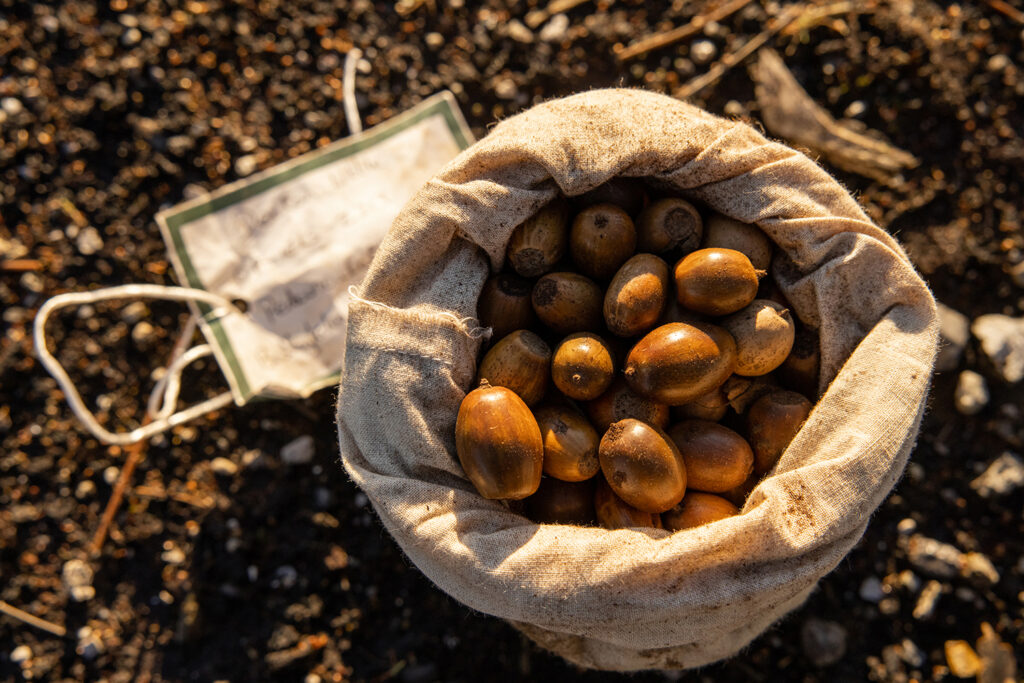On what seemed an unseasonably warm December day, some of the Coillte Nature team visited the Midlands Native Woodland Project demonstration site to sow acorns and plant young oak trees in new trial plots, as an addition to our 2020 native tree, shrub, cuttings and seed trials.
Whatever the weather, there’s always a good feeling about planting trees or sowing seed at this time of year, thinking of the new growth to come while we are in the winter period which can often be so cold and dark!
 The oak has been planted and seeded on areas of shallow and medium peat depths, to partly mimic a type of oak woodland sometimes found on eskers running through raised bog landscapes. As well as pedunculate oak, this type of woodland would typically include a lovely mix of native trees and shrubs such as hazel, ash, cherry, spindle and dog rose.
The oak has been planted and seeded on areas of shallow and medium peat depths, to partly mimic a type of oak woodland sometimes found on eskers running through raised bog landscapes. As well as pedunculate oak, this type of woodland would typically include a lovely mix of native trees and shrubs such as hazel, ash, cherry, spindle and dog rose.
Collaborating with Bord na Mona
The Midlands Native Woodland project is a collaboration with Bord na Mona to establish native pioneer woodland on a number of midland cutaway raised bogs in the Littleton Bog Complex in counties Kilkenny and Tipperary. Only 5% of the total area at Littleton is suitable for native woodland establishment, with the majority of land undergoing a rewetting process. However, on higher and dryer sections of the cutaway bog, which cannot be rewet, Coillte Nature plans to establish areas of native trees, shrubs and vegetation, taking our lead from the natural woodland regeneration that is occurring presently. The aim is to speed up the regeneration process and stabilise the bare peat, in order to reduce soil (peat) erosion and CO2 emissions.
An exciting and innovative project
 Ecological Lead for Coillte Nature, Declan Little, is enthusiastic about the prospects for this project saying ‘this is a hugely exciting and innovative project with great potential for the reduction of soil erosion and carbon emissions. However, we are working in what is a very challenging environment with seedlings and young trees exposed to harsh, cold winds, heavy rain and even prolonged spring droughts. Despite this we have had very good results from both seeding and planting trials on the shallower and medium peat depth over the last two years and this will inform our woodland establishment approach in the future’.
Ecological Lead for Coillte Nature, Declan Little, is enthusiastic about the prospects for this project saying ‘this is a hugely exciting and innovative project with great potential for the reduction of soil erosion and carbon emissions. However, we are working in what is a very challenging environment with seedlings and young trees exposed to harsh, cold winds, heavy rain and even prolonged spring droughts. Despite this we have had very good results from both seeding and planting trials on the shallower and medium peat depth over the last two years and this will inform our woodland establishment approach in the future’.
Extensive trials on the seeding and planting of native tree and shrub species including birch, Scots pine, alder and willow have been carried out here to find the best methods for establishing native woodland under these conditions. You can learn more about our trials in our earlier blog and on our Midland Native Woodland project web page here. Over the last 18 months, significant work has gone into compiling a Form 1 Afforestation Application for just over 200 hectares (about 5% of the total Littleton Bog complex) and an Environmental Impact Assessment (EIA) report, along with a Natura Impact Statement (NIS), all of which have been submitted to the Department of Agriculture, Food and the Marine and are currently under review.








